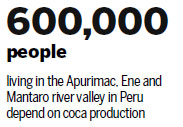Farmers fear nation's government will cut off coca lifeline
Just before sunrise, Raul Rua joins 15 others, including women, teenagers and children, for a half-hour walk to pick coca in the world's No 1 coca-producing valley.
Blisters and calluses cover his hands from long days of picking. But the work is the best he and others can find.
"If it weren't for this little coca leaf, there would be no food," Rua said.
The more than 600,000 people living in the Apurimac, Ene and Mantaro river valley depend on coca production. It is the reason many settled in the remote region where the Andes ridge meets the Amazon basin.
Nearly all the coca they pick ends up being processed into cocaine, and many worry that Peru's government will finally begin destroying the crop, as it has elsewhere.
"We aren't drug traffickers, but the coca leaf is the only sustenance for small-scale farmers," said Prospero Ayala, representative of the valley's agriculture federation. "The government spends so much on the military, the police, but hardly anything on education, healthcare or the people."
Farmers might be able to afford to abandon the crop if the government were to improve living conditions in the valley 370 kilometers southeast of Lima, he said. Official figures show more than two-thirds of its inhabitants live in poverty, while chronic malnutrition plagues about half of children under 5.
"Here the children suffer. They are full of parasites. The education is terrible, and let's not even talk about healthcare," Ayala said.

Some 17,000 children of coca pickers have not been to classes in a month because teachers are on strike in support of a demand that their $300 monthly salary be increased by $581.
Pickers earn about 33 US cents per kilogram of coca leaf, adding up to about $16 a day for the average yield. According to United Nations figures, some 99,000 metric tons of coca leaves were picked in the valley in 2013, compared to 22,000 tons in other parts of Peru.
Farm owners sell a kilogram of leaves for $3.50 to wholesalers who supply drug traffickers. That's more than twice what farmers would earn for coffee or cacao, Ayala said.
If farmers could earn $4.70 for a kilogram of coffee or cacao, a landowner with 2 hectares could earn more than $9,000 a year and "we would be secure, without having to grow coca leaves," he said.
Coca farmers were among the locals who, in 1984, formed citizen militias to help the military beat back Shining Path rebels, reducing the movement to a small group of fewer than 500 who are now deeply involved in drug trafficking.
(China Daily 07/01/2015 page11)












